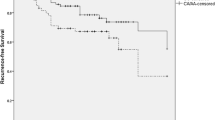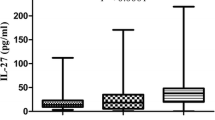Abstract
Accumulating evidence suggests that inflammatory process may play a role in bladder carcinogenesis. However, the exact mechanisms of how the inflammatory factors associate with bladder cancer risk are still unknown. In this study, we explored whether polymorphisms (i.e. IL-4 C-590T, IL-4R Ile50Val, IL-4R Ser478Pro, IL-4R Gln551Arg, IL-13 C-1055T and IL-13 Arg130Gln) of IL-4, IL-4R and IL-13 genes predicted Chinese bladder cancer risk in 817 bladder cancer and 1,141 controls. Genotyping was performed by using the TaqMan method. We did not find any overall association between these single nucleotide polymorphisms (SNPs) and bladder cancer susceptibility in a Chinese population. However, in the classification and regression tree (CART) analysis, we found that carriers of IL-13 C-1055T variant genotype in smokers had a 2.57-fold increased bladder cancer risk with a 55% patient rate (OR = 2.57; 95% CI = 1.93-3.43), comparing with non-smokers. Similar result was also observed in combination of IL-13 C-1055T and IL-13 Arg130Gln in smokers. By multifactor dimensionality reduction (MDR) analysis, the best interaction model was the two-factor model that smokers with the IL-13 C-1055T genotypes were the subgroup to predict bladder cancer risk. The results suggested that the genetic variants in IL-4, IL-4R and IL-13 genes might modulate the bladder cancer risk in a Chinese population.

Similar content being viewed by others
References
Kakehi Y, Hirao Y, Kim WJ, Ozono S, Masumori N, Miyanaga N, Nasu Y, Yokomizo A (2010) Bladder Cancer Working Group report. Jpn J Clin Oncol 40(Suppl 1):i57–i64
Parkin DM (2004) International variation. Oncogene 23(38):6329–6340
Hainaut P, Pfeifer GP (2001) Patterns of p53 G→T transversions in lung cancers reflect the primary mutagenic signature of DNA-damage by tobacco smoke. Carcinogenesis 22(3):367–374
Ames BN, Gold LS, Willett WC (1995) The causes and prevention of cancer. Proc Natl Acad Sci USA 92(12):5258–5265
Opal SM, DePalo VA (2000) Anti-inflammatory cytokines. Chest 117(4):1162–1172
Noguchi E, Nukaga-Nishio Y, Jian Z, Yokouchi Y, Kamioka M, Yamakawa-Kobayashi K, Hamaguchi H, Matsui A, Shibasaki M, Arinami T (2001) Haplotypes of the 5′ region of the IL-4 gene and SNPs in the intergene sequence between the IL-4 and IL-13 genes are associated with atopic asthma. Hum Immunol 62(11):1251–1257
Mitsuyasu H, Izuhara K, Mao XQ, Gao PS, Arinobu Y, Enomoto T, Kawai M, Sasaki S, Dake Y, Hamasaki N, Shirakawa T, Hopkin JM (1998) Ile50Val variant of IL4R alpha upregulates IgE synthesis and associates with atopic asthma. Nat Genet 19(2):119–120
Kruse S, Japha T, Tedner M, Sparholt SH, Forster J, Kuehr J, Deichmann KA (1999) The polymorphisms S503P and Q576R in the interleukin-4 receptor alpha gene are associated with atopy and influence the signal transduction. Immunology 96(3):365–371
Hershey GK, Friedrich MF, Esswein LA, Thomas ML, Chatila TA (1997) The association of atopy with a gain-of-function mutation in the alpha subunit of the interleukin-4 receptor. N Engl J Med 337(24):1720–1725
Palmer LJ, Daniels SE, Rye PJ, Gibson NA, Tay GK, Cookson WO, Goldblatt J, Burton PR, LeSouef PN (1998) Linkage of chromosome 5q and 11q gene markers to asthma-associated quantitative traits in Australian children. Am J Respir Crit Care Med 158(6):1825–1830
Callard RE, Matthews DJ, Hibbert L (1996) IL-4 and IL-13 receptors: are they one and the same? Immunol Today 17(3):108–110
Terabe M, Matsui S, Noben-Trauth N, Chen H, Watson C, Donaldson DD, Carbone DP, Paul WE, Berzofsky JA (2000) NKT cell-mediated repression of tumor immunosurveillance by IL-13 and the IL-4R-STAT6 pathway. Nat Immunol 1(6):515–520
Cameron L, Webster RB, Strempel JM, Kiesler P, Kabesch M, Ramachandran H, Yu L, Stern DA, Graves PE, Lohman IC, Wright AL, Halonen M, Klimecki WT, Vercelli D (2006) Th2 cell-selective enhancement of human IL13 transcription by IL13-1112C>T, a polymorphism associated with allergic inflammation. J Immunol 177(12):8633–8642
Graves PE, Kabesch M, Halonen M, Holberg CJ, Baldini M, Fritzsch C, Weiland SK, Erickson RP, von Mutius E, Martinez FD (2000) A cluster of seven tightly linked polymorphisms in the IL-13 gene is associated with total serum IgE levels in three populations of white children. J Allergy Clin Immunol 105(3):506–513
Wang M, Wang M, Yuan L, Wu D, Zhang Z, Yin C, Fu G, Wei Q, Zhang Z (2010) A novel XPF -357A>C polymorphism predicts risk and recurrence of bladder cancer. Oncogene 29(13):1920–1928
Hochberg Y, Benjamini Y (1990) More powerful procedures for multiple significance testing. Stat Med 9(7):811–818
Zhang H, Bonney G (2000) Use of classification trees for association studies. Genet Epidemiol 19(4):323–332
Hahn LW, Ritchie MD, Moore JH (2003) Multifactor dimensionality reduction software for detecting gene–gene and gene–environment interactions. Bioinformatics 19(3):376–382
Ritchie MD, Hahn LW, Roodi N, Bailey LR, Dupont WD, Parl FF, Moore JH (2001) Multifactor-dimensionality reduction reveals high-order interactions among estrogen-metabolism genes in sporadic breast cancer. Am J Hum Genet 69(1):138–147
Lin WW, Karin M (2007) A cytokine-mediated link between innate immunity, inflammation, and cancer. J Clin Invest 117(5):1175–1183
Terabe M, Matsui S, Park JM, Mamura M, Noben-Trauth N, Donaldson DD, Chen W, Wahl SM, Ledbetter S, Pratt B, Letterio JJ, Paul WE, Berzofsky JA (2003) Transforming growth factor-beta production and myeloid cells are an effector mechanism through which CD1d-restricted T cells block cytotoxic T lymphocyte-mediated tumor immunosurveillance: abrogation prevents tumor recurrence. J Exp Med 198(11):1741–1752
Nedoszytko B, Niedoszytko M, Lange M, van Doormaal J, Glen J, Zablotna M, Renke J, Vales A, Buljubasic F, Jassem E, Roszkiewicz J, Valent P (2009) Interleukin-13 promoter gene polymorphism -1112C/T is associated with the systemic form of mastocytosis. Allergy 64(2):287–294
Wang SS, Carreon JD, Hanchard B, Chanock S, Hisada M (2009) Common genetic variants and risk for non-Hodgkin lymphoma and adult T-cell lymphoma/leukemia in Jamaica. Int J Cancer 125(6):1479–1482
MalekZadeh K, Nikbakht M, Sadeghi IA, Singh SK, Sobti RC (2010) Overexpression of IL-13 in patients with bladder cancer. Cancer Invest 28(2):201–207
Sameni S, Ghayumi MA, Mortazavi G, Faghih Z, Kashef MA, Ghaderi A (2009) Lack of association between interleukin-13 gene polymorphisms (-1055 C/T and +2044 G/A) in Iranian patients with lung cancer. Mol Biol Rep 36(5):1001–1005
Muller-Hermelink N, Braumuller H, Pichler B, Wieder T, Mailhammer R, Schaak K, Ghoreschi K, Yazdi A, Haubner R, Sander CA, Mocikat R, Schwaiger M, Forster I, Huss R, Weber WA, Kneilling M, Rocken M (2008) TNFR1 signaling and IFN-gamma signaling determine whether T cells induce tumor dormancy or promote multistage carcinogenesis. Cancer Cell 13(6):507–518
Swain SL, Weinberg AD, English M, Huston G (1990) IL-4 directs the development of Th2-like helper effectors. J Immunol 145(11):3796–3806
Olson SH, Orlow I, Simon J, Tommasi D, Roy P, Bayuga S, Ludwig E, Zauber AG, Kurtz RC (2007) Allergies, variants in IL-4 and IL-4R alpha genes, and risk of pancreatic cancer. Cancer Detect Prev 31(5):345–351
Sugimoto M, Yamaoka Y, Furuta T (2010) Influence of interleukin polymorphisms on development of gastric cancer and peptic ulcer. World J Gastroenterol 16(10):1188–1200
Landi S, Bottari F, Gemignani F, Gioia-Patricola L, Guino E, Osorio A, de Oca J, Capella G, Canzian F, Moreno V (2007) Interleukin-4 and interleukin-4 receptor polymorphisms and colorectal cancer risk. Eur J Cancer 43(4):762–768
Chen M, Kamat AM, Huang M, Grossman HB, Dinney CP, Lerner SP, Wu X, Gu J (2007) High-order interactions among genetic polymorphisms in nucleotide excision repair pathway genes and smoking in modulating bladder cancer risk. Carcinogenesis 28(10):2160–2165
Cozen W, Diaz-Sanchez D, James Gauderman W, Zadnick J, Cockburn MG, Gill PS, Masood R, Hamilton AS, Jyrala M, Mack TM (2004) Th1 and Th2 cytokines and IgE levels in identical twins with varying levels of cigarette consumption. J Clin Immunol 24(6):617–622
Simhan HN, Caritis SN, Hillier SL, Krohn MA (2005) Cervical anti-inflammatory cytokine concentrations among first-trimester pregnant smokers. Am J Obstet Gynecol 193(6):1999–2003
Schmid-Grendelmeier P, Altznauer F, Fischer B, Bizer C, Straumann A, Menz G, Blaser K, Wuthrich B, Simon HU (2002) Eosinophils express functional IL-13 in eosinophilic inflammatory diseases. J Immunol 169(2):1021–1027
Margel D, Pevsner-Fischer M, Baniel J, Yossepowitch O, Cohen IR (2011) Stress proteins and cytokines are urinary biomarkers for diagnosis and staging of bladder cancer. Eur Urol 59(1):113–119
Zhai R, Chen F, Liu G, Su L, Kulke MH, Asomaning K, Lin X, Heist RS, Nishioka NS, Sheu CC, Wain JC, Christiani DC (2010) Interactions among genetic variants in apoptosis pathway genes, reflux symptoms, body mass index, and smoking indicate two distinct etiologic patterns of esophageal adenocarcinoma. J Clin Oncol 28(14):2445–2451
Acknowledgments
This study was partly supported by National Natural Science Foundation of China (30872084, 30972444, 30901166, and 81102089), the key program of National Natural Science Foundation of Jiangsu Province (BK2010080), National Natural Science Foundation of Jiangsu Province (BK2011773), The Key Program for Basic Research of Jiangsu Provincial Department of Education (08KJA330001, and 11KJB330002), and the Project Funded by the Priority Academic Program Development of Jiangsu (Public Health and Preventive Medicine).
Conflict of interest
None.
Author information
Authors and Affiliations
Corresponding author
Additional information
Haiyan Chu, Lan Ma, and Meilin Wang should be regarded as joint first authors.
Rights and permissions
About this article
Cite this article
Chu, H., Ma, L., Wang, M. et al. The polymorphisms of IL-4, IL-4R and IL-13 genes and bladder cancer risk in a Chinese population: a case–control study. Mol Biol Rep 39, 5349–5357 (2012). https://doi.org/10.1007/s11033-011-1334-9
Received:
Accepted:
Published:
Issue Date:
DOI: https://doi.org/10.1007/s11033-011-1334-9




